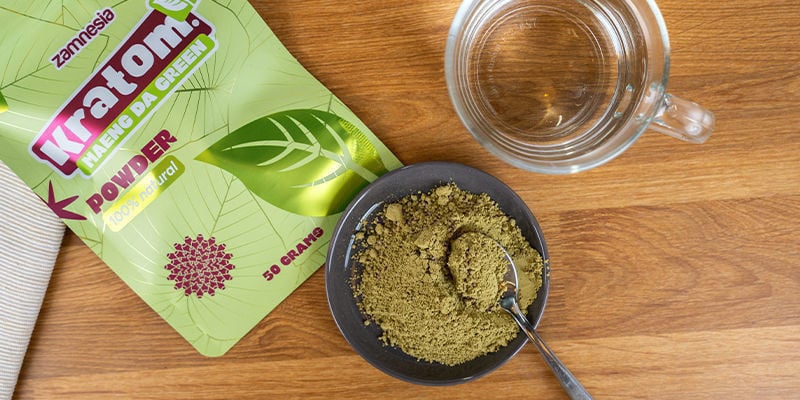How to prevent kratom nausea
Kratom nausea is a common and sometimes very unpleasant experience. Sometimes it's unavoidable, but much of the time it can be reduced and managed—if you understand why it occurs. Here we explain what you can do to keep kratom nausea to a minimum.
Kratom (Mitragyna speciosa) is a tropical tree native to Southeast Asia, well-known for its alkaloid-rich leaves that produce stimulating and soporific effects, depending on the dose. However, one of the most common and unpleasant side effects reported is nausea, which can range from mild discomfort to severe queasiness and vomiting.
In this article, we will help you understand the ways in which kratom can cause nausea and what you can do to manage it!
What is kratom nausea?

Kratom produces its effects on the body chiefly by interacting with opioid and mu-opioid receptors in the brain. All drugs that work on the opioid receptors have the potential to cause feelings of nausea, especially in new users. So this is the most common reason that kratom causes nausea.
It can be mild and pass quickly, or it can become severe, leading to vomiting, dizziness, and general unease. The intensity of nausea varies depending on factors such as dose, individual tolerance, and method of ingestion. Though kratom can cause nausea at all doses, higher doses are more likely to lead to this unwanted side effect.
Understanding the root causes of kratom nausea can help users take preventive steps to avoid or minimize its effects. At the very least, knowing why it happens and that it will pass can help users feel more at ease with their nausea.
What causes kratom nausea?

There are numerous factors that can influence whether users end up feeling nausea when they consume kratom, including:
- Overconsumption: Taking too high a dose of kratom increases the likelihood of nausea, as large amounts of alkaloids can overwhelm the body.
- Alkaloid sensitivity: Kratom contains the alkaloids mitragynine and 7-hydroxymitragynine, which interact with opioid receptors. Some people are more sensitive to these compounds than others, especially new users.
- Consumption method: Swallowing raw kratom powder directly (toss and wash) can irritate the stomach lining, leading to nausea.
- Empty stomach consumption: Taking kratom on an empty stomach can intensify its effects but also increase the risk of nausea.
- Dehydration: Kratom can be dehydrating, and inadequate water intake can exacerbate nausea.
- Poor-quality kratom: Old, contaminated, or low-quality kratom may contain impurities that upset the stomach.
- Mixing with other substances: Combining kratom with alcohol, caffeine, or certain medications may worsen nausea.
Kratom nausea symptoms
Even mild nausea is generally hard to ignore, but there are a few symptoms you can keep an eye out for. Here’s a checklist of nausea symptoms associated with kratom use:
Mild symptoms:
- General queasiness
- Lightheadedness
- Slight stomach discomfort
Moderate symptoms:
- Dizziness
- Sweating
- Increased salivation
- A sensation of warmth or flushing
Severe symptoms:
- Vomiting
- Headaches
- Uncontrollable gagging
- Difficulty focusing
- Lethargy or extreme drowsiness
How to prevent kratom nausea

In most cases, kratom nausea can be prevented or at least managed. When it comes to new users, you might just have to accept a degree of nausea—it’s simply the nature of certain psychoactive compounds. However, most of the other causes of nausea can be averted with adequate preparation!
Be careful with dosing
Lower doses will reduce the chances and severity of nausea. Low doses (1–2 grams) will significantly lower the occurrence of nausea, but they won’t fully mitigate it for everyone. Doses over 5 grams will make the chances of nausea much greater.
Finally, different strains contain different ratios of alkaloids, so you should be aware of these ratios and adjust your dose accordingly.
Antacids 30 minutes before, light snack 30 minutes after
Antacids, such as baking soda, are alkaline and will help to neutralize stomach acid that causes irritation. Take this around 30 minutes prior to consuming kratom to help manage the effects of nausea.
Then, around 30 minutes after consumption, it can help to consume a light snack, such as yogurt. This is also alkaline and will absorb excess alkaloids and ease digestion. Heavy and greasy foods will probably worsen nausea and therefore should be avoided.
Make tea instead of toss and wash
When it comes to avoiding nausea, tea is a much better option compared to the toss-and-wash consumption method. Boil kratom leaves or powder extracts in water to avoid consuming the plant matter, which will help to reduce nausea.
Adding lemon and honey will further ease the stomach and make the whole experience significantly more pleasant. Finally, slow, gentle sipping is better than downing it, and will also make it easier on the stomach.
Use ginger or peppermint
Adding ginger and peppermint to your tea, or consuming a tea after toss and wash, will help to settle the stomach as they have anti-nausea properties and soothe digestion. Alternatively, other herbs like chamomile and fennel can also help to reduce nausea (and they taste good)!
Rest up
Finally, just lie down and wait for it to pass—sometimes this is all you can do. Find a cool and quiet space; this will be much more restful than a stuffy, busy environment. Try to lie still and avoid sudden movements as these can upset the stomach and head, increasing feelings of nausea and even causing you to vomit.
Slow breathing will also help to calm the body and mind, reducing nausea symptoms and the anxiety they can bring on.
Enjoy kratom with confidence and comfort

Kratom can be an enjoyable and beneficial plant when used responsibly, but nausea can be an unfortunate side effect for some users. Understanding what causes kratom nausea and how to prevent it ensures a smoother and more comfortable experience. Simple steps, such as adjusting the dose, choosing tea over raw powder, staying hydrated, and using natural remedies like ginger, can significantly reduce nausea risk.
By being mindful of how and when kratom is consumed, users can experience its benefits without unnecessary discomfort. Whether using kratom for relaxation, focus, or well-being, taking preventative measures will help enhance its positive effects while minimizing unwanted side effects such as nausea.
-
 4 min
March 7, 2025
Kratom safety & side effects: What you need to know
Kratom exhibits different effects and side effects depending on the dose. Relatively poorly studied compared to many other drugs, there's a lot we don't know about this strange plant and its...
4 min
March 7, 2025
Kratom safety & side effects: What you need to know
Kratom exhibits different effects and side effects depending on the dose. Relatively poorly studied compared to many other drugs, there's a lot we don't know about this strange plant and its...
-
 5 min
March 3, 2025
Kratom dosing guide: Everything you need to know
Dosing kratom can be difficult. You need to take into account tolerance, body weight, the specific strain, and, unusually, what kind of effects you're looking for. Here's what you need to know.
5 min
March 3, 2025
Kratom dosing guide: Everything you need to know
Dosing kratom can be difficult. You need to take into account tolerance, body weight, the specific strain, and, unusually, what kind of effects you're looking for. Here's what you need to know.
-
 4 min
December 31, 2024
The Diverse Effects Of Kratom
Kratom can energise and lift you up, but it can also bring about relaxation and help you sleep. Interested to find out more about this strange plant? Then keep reading to become acquainted with the...
4 min
December 31, 2024
The Diverse Effects Of Kratom
Kratom can energise and lift you up, but it can also bring about relaxation and help you sleep. Interested to find out more about this strange plant? Then keep reading to become acquainted with the...
-
 3 min
December 27, 2024
How To Consume Kratom
Kratom can be consumed in numerous ways and offers unique effects depending on the dose, strain, and other factors. Here we look at the different consumption methods for kratom, examining the...
3 min
December 27, 2024
How To Consume Kratom
Kratom can be consumed in numerous ways and offers unique effects depending on the dose, strain, and other factors. Here we look at the different consumption methods for kratom, examining the...








 United States
United States









